
- Other Issues
- >> The Gulfstream Issue
- >> Dive products and New...REBREATHER
- >> The Rebreather
New Hi-Tech Products Pages
Our hottest test this month is the new rebreather by BMD. If you are a cave diver with deep penetrations in your future, a deep technical diver with aspirations for unexplored wrecks in the 500 foot deep+ range, or even a photographer or videographer who demands silent running and bottom time matching the demands of the moment, this rebreather deserves a look. |
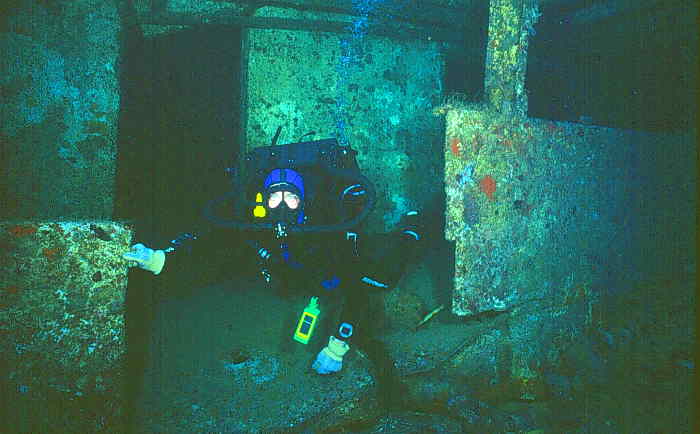 |
As you take a look at this unit, its becomes clear that some special training would probably be in order. |
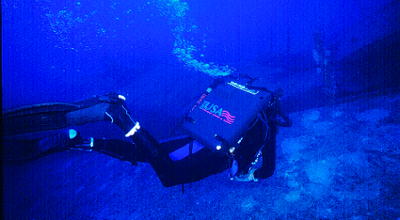 |
As you take a look at this unit, its becomes clear that some special training would probably be in order. |
Todd Ives of Dive USA, (Todd has an instructor rating on this system) has acquired this system, among many others you'll soon read about, for use in Dive USA's Technical Diver Training Courses. |
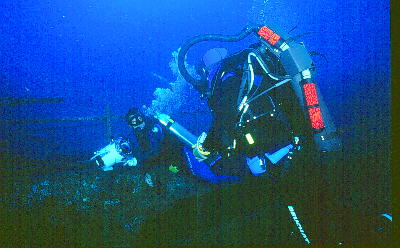 |
It has multiple redundancy built in, its shape has very low drag for higher swimming speed with less effort, and five hour long bottom times are easily within its scope. |
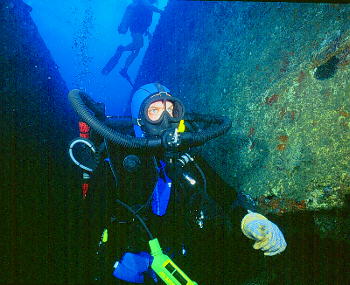 |
We first tested the unit with Todd on a wreck off of West Palm Beach, known as the Princess Ann. The depth was only 100-110 feet to the bottom, but the penetrations deep within this ship are way beyond sport diving boundaries. It was once a five level ferry boat, close to 500 feet long. Two of the floors have collapsed so far, and while what's left is intriguing, it is dangerous. |
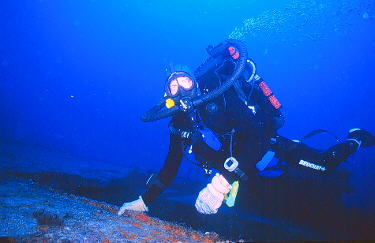 |
Todd's dive was 51 minutes on this wreck, and his impressions about this rebreather on this wreck follow: ...."In all fairness to BMD, any rating I provide you with of the BMD SCR-4, is a comparison between a real rebreathing system you can use right now, and several ghosts....we keep hearing about new rebreather systems, and even get the chance to touch a few, but thats it". "You can't dive the others yet. So this BMD SRC-4 is really the first and only rebreather at this time." |
A good first question would be, "Why would I want a rebreather?" "Most rebreather divers are mission oriented. Rebreathers are a tool to fullfill their mission. Your mission might be to film schooling hammerheads or to penetrate extreme depths into an overhead environment. (If you were in the military you would be using a rebreather for stealth, stalking silently to suprise an enemy) You might want a rebreather to accomplish missions not feasible with open circuit scuba. Among the advantages the rebreather offers are: |
"My personal impressions of using the system: The unit is about 20 pounds buoyant which compensates for additional cylinder capacity(if you carry two extra stage bottles for different gas mixtures). Its very comfortable and very streamlined. Very easy breathing. Because of the tuned loop, there is stable buoyoncy---unaffected by breathing.... The photographer finds it easier to stay in position, the wreck or cave diver finds it easier to navigate tight areas at low speeds. The unit is fifty-two pounds fully packed and loaded, so setting up and entering the water, or even climbing back into the boat have never been easier (compared again to a traditional deep exposure doubles setup). Complete set up including gas fill and scrubber load takes only 20 minutes tops! Cost of gas and scrubber runs less than $10.00 for a four or five hour exposure! After dive maintainance is another 15 minutes. With everything this perfect there has to be a catch somewhere...it costs a little more than a set of doubles...around $15,000 total plus training. Considering this unit can open up exploration and experiences not possible otherwise, those on the cutting edge of technical frontiers will find it affordable. |
[Go to Dive USA's Technical School for more information]